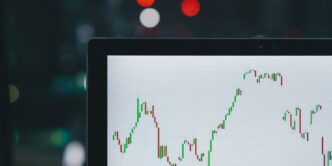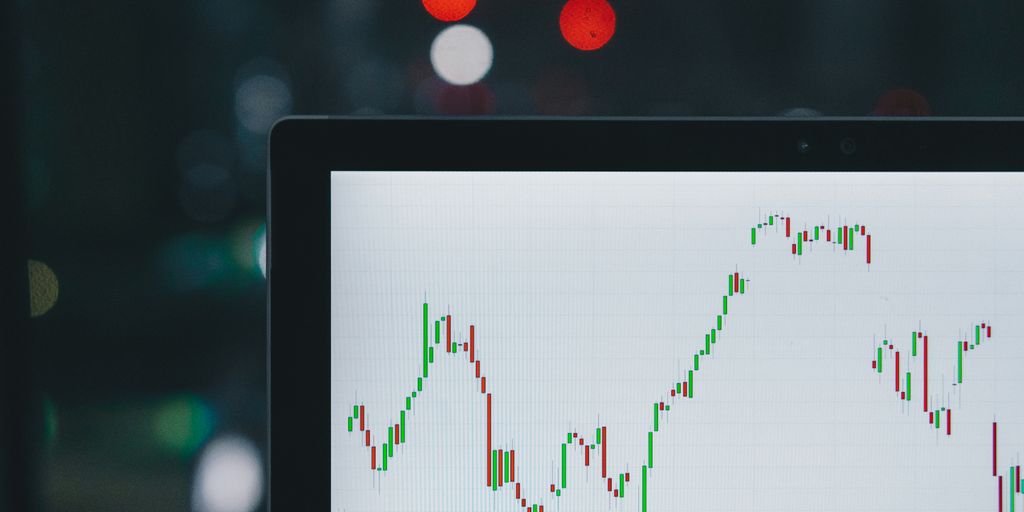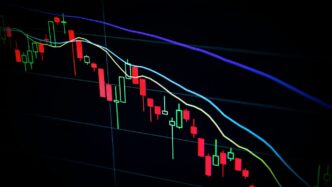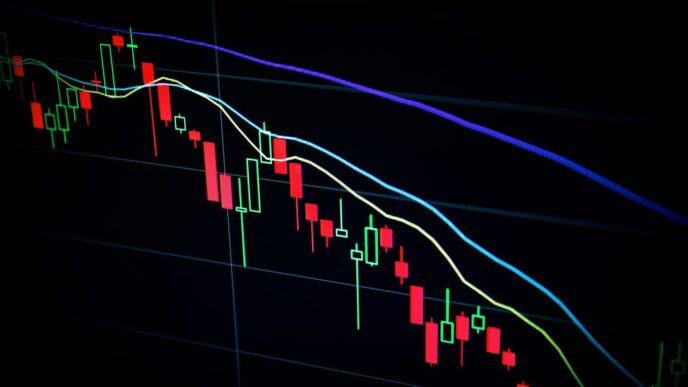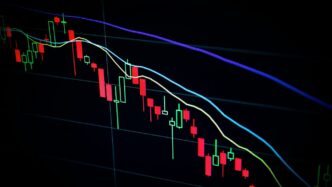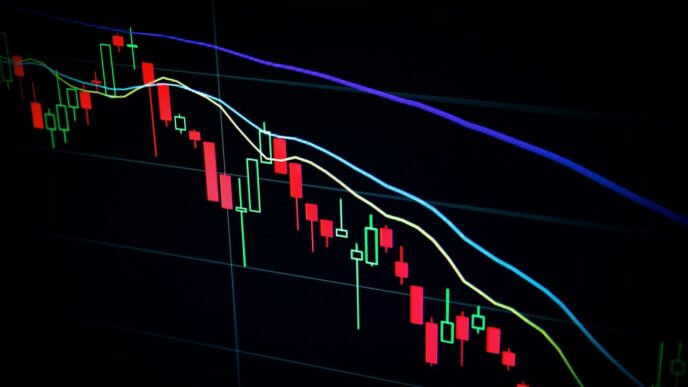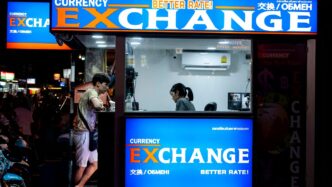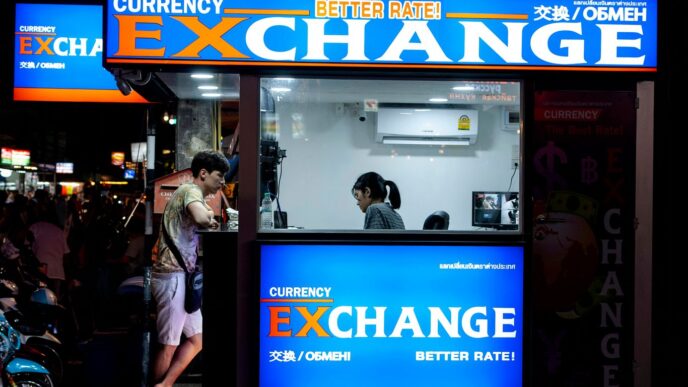You might hear a lot about the 5 year treasury on CNBC and wonder what all the fuss is about. It’s not just some fancy financial term; what happens with these government bonds can actually shake up your own money plans. We’re going to break down why this specific treasury matters, how it connects to your investments, and what’s going on in the market right now that you should know about.
Key Takeaways
- The 5 year treasury yield is a key indicator, showing how much return you can expect from holding a bond for five years.
- When bond prices go down, yields go up, and vice versa; this relationship is important for understanding market movements.
- Current market trends show that shorter-term bonds are looking more attractive to investors right now.
- Things like government spending, inflation, and Federal Reserve decisions all play a big part in how the 5 year treasury behaves.
- Thinking about diversifying your investments beyond just traditional bonds might be a smart move, especially given recent market shifts.
Understanding the 5 Year Treasury on CNBC

What the 5 Year Treasury Yield Signifies
The 5-year Treasury yield is a benchmark rate that reflects the market’s expectations for interest rates and economic growth over the next five years. It’s a key indicator that CNBC often highlights because it sits in a sweet spot, not too short-term and not too long-term, making it a good gauge of overall economic sentiment. It’s more sensitive to economic data and Fed policy changes than shorter-term yields, but less reactive to long-term uncertainties than the 10- or 30-year bonds. When you see CNBC talking about the 5-year Treasury, they’re essentially giving you a snapshot of how investors feel about the intermediate future of the economy. It’s worth paying attention to!
How Bond Prices and Yields Interact
Bond prices and yields have an inverse relationship. This means when bond prices go up, yields go down, and vice versa. It’s like a seesaw. If there’s increased demand for U.S. debt, bond prices rise, and yields fall. Conversely, if investors are selling off bonds, prices drop, and yields climb. CNBC often explains this relationship because it’s crucial for understanding market movements. For example, concerns about fiscal spending or a U.S. credit downgrade can lead to a bond sell-off, pushing yields higher. This inverse relationship is something every investor needs to grasp.
Why CNBC Focuses on Treasury Movements
CNBC pays close attention to Treasury movements because they provide insights into the overall health of the economy and investor sentiment. Here’s why:
- Economic Barometer: Treasury yields reflect expectations about economic growth, inflation, and interest rates.
- Market Stability: Significant swings in Treasury yields can signal market instability or shifts in investor risk appetite.
- Policy Implications: The Fed uses Treasury yields as a key input when making monetary policy decisions.
Plus, big players like Warren Buffett are known to invest heavily in short-term treasuries, so it’s always good to know what’s going on. When CNBC reports on Treasury yields, they’re not just talking about bonds; they’re talking about the broader economic landscape and what it means for your investments.
Impact of Treasury Yields on Your Portfolio
Navigating Volatility in Fixed Income
Fixed income can feel like a rollercoaster these days. Rising Treasury yields mean bond prices are falling, creating volatility. It’s important to remember that this doesn’t necessarily mean you should panic. Instead, consider your risk tolerance and time horizon. Short-term fluctuations are normal, and a well-diversified portfolio can weather the storm. Investors are steering clear of longer-term Treasuries amid volatility in bond yields and prices.
Reassessing Long-Term Bond Allocations
With yields on longer-dated Treasurys rising, it might be time to rethink your long-term bond allocations. Are you comfortable with the potential for further price declines if yields continue to climb? Consider these points:
- Duration: Longer-term bonds have higher duration, meaning they are more sensitive to interest rate changes.
- Risk Tolerance: If you’re close to retirement, you might want to reduce your exposure to long-term bonds.
- Diversification: Don’t put all your eggs in one basket. Diversify your fixed income holdings across different maturities and credit qualities.
The Appeal of Shorter-Duration Investments
Shorter-duration investments are becoming increasingly attractive in this environment. Because they mature sooner, they are less sensitive to interest rate changes. This can help to reduce volatility in your portfolio. Ultra-short bond ETFs have been among the most popular exchange-traded funds with investors in 2025. Consider these options:
- Treasury Bills: These are short-term debt obligations issued by the U.S. government.
- Short-Term Bond Funds: These funds invest in bonds with maturities of one to five years.
- Certificates of Deposit (CDs): These are time deposits offered by banks and credit unions.
Current Trends in the Treasury Market
Rising Yields on Longer-Dated Treasurys
Recently, there’s been a noticeable increase in yields, especially for longer-term Treasury bonds. Yields on 20- and 30-year Treasuries have seen upticks, reflecting some market unease. This rise in yields can be attributed to a few things, including concerns about U.S. fiscal policy and the overall economic outlook. The increase in yields on longer-dated Treasurys has prompted some investors to reassess their fixed income allocations.
Short-Term Treasury Performance
While longer-term yields have been climbing, short-term Treasuries are showing a different picture. There’s less volatility and more stable yields in the short and middle parts of the yield curve. For example, the 3-month T-Bill is currently offering an annualized yield above 4.3%. This relative stability is making shorter-term Treasury notes attractive to some investors seeking safety and liquidity.
Investor Shift Towards Ultra-Short Bond ETFs
Given the uncertainty in the market, there’s a growing trend of investors moving towards ultra-short bond ETFs. These ETFs focus on very short-term debt, minimizing exposure to interest rate risk. This shift reflects a desire for capital preservation and a more conservative approach to fixed income investing. Investors are seeking stability and are willing to sacrifice some yield for reduced volatility. The appeal of ultra-short bond ETFs lies in their ability to provide a relatively safe haven in a potentially turbulent market environment.
Economic Factors Influencing the 5 Year Treasury
Concerns Over U.S. Fiscal Spending
Okay, so the 5-year Treasury yield isn’t just some random number floating around. It’s heavily influenced by what’s happening with U.S. fiscal policy. Think about it: if the government is spending like crazy, and especially with Republican spending bill plans, that means more debt. More debt often translates to higher Treasury yields as investors demand a higher return to compensate for the increased risk. It’s like, if you’re lending money to someone who already owes a ton, you’re gonna want a better interest rate, right?
The Role of Inflation and Fed Policy
Inflation is a HUGE player here. If inflation starts creeping up, the Fed usually steps in to try and cool things down, often by raising interest rates. Higher rates make Treasury yields more attractive. The Fed’s actions and signals about future policy are constantly being watched by the market. Remember when the Fed paused rate cuts because of inflation worries? That kind of thing sends ripples through the bond market. It’s a constant balancing act, and the 5-year Treasury is right in the middle of it all.
U.S. Credit Downgrades and Market Jitters
And then there are the curveballs, like U.S. credit downgrade. When a major ratings agency downgrades U.S. debt, it shakes investor confidence. People start questioning the "safe-haven" status of U.S. bonds, and that can lead to a sell-off. The yields go up as bond prices fall. It’s all connected. The market gets jittery, and the 5-year Treasury feels the impact. It’s a reminder that even seemingly stable investments can be affected by broader economic anxieties.
Strategic Investment Decisions
Diversifying Beyond Traditional Fixed Income
Okay, so you’re watching the 5-Year Treasury on CNBC and starting to sweat a little? Time to think outside the box. Don’t put all your eggs in one basket, especially if that basket is solely filled with traditional bonds. Consider other asset classes like real estate, commodities, or even dividend-paying stocks. These can act as a buffer when bond yields are all over the place. I’ve been reading up on alternative investments and they seem like a good way to go.
Considering Emerging Market Bonds
Emerging market bonds can offer higher yields than U.S. Treasuries, but they also come with more risk. It’s a balancing act. You’re chasing higher returns, but you need to be aware of currency fluctuations and political instability. Do your homework before jumping in. Maybe allocate a small percentage of your portfolio to these, and keep a close eye on things. It’s like adding a little spice to your investment stew – too much and it ruins the whole thing.
Lessons from Warren Buffett’s Treasury Holdings
Warren Buffett is a legend for a reason. He’s known for his long-term, value-oriented approach. When it comes to Treasuries, he often emphasizes safety and liquidity. He’s not trying to time the market; he’s looking for solid, dependable investments. The key takeaway? Don’t get greedy. Sometimes, the best move is to stick with quality, even if it means lower returns. Think about his moves as a guide to long-term investing strategies.
The ‘Emerging Markets Trap’ Warning
Analyst Perspectives on U.S. Debt
There’s a growing unease about the rising U.S. federal debt. One analyst described the increase in U.S. Treasury yields as "relentless," reflecting this concern. It’s like when you’re casually adding things to your online shopping cart, and suddenly, the total is way higher than you expected. That’s kind of what’s happening with the U.S. debt situation.
Comparing U.S. and International Yields
Investors are starting to notice that other countries offer competitive yields without the same level of risk that they perceive in the U.S. For example, Japanese investors can now get decent returns on their own domestic bonds, reducing the incentive to invest in U.S. Treasuries and deal with currency risk. It’s like choosing between a local restaurant you know and love versus trying a new place that’s further away and might not be as good. Some are choosing to stay closer to home. Some investors are looking to diversify their fixed income allocation to other parts of the world.
Rethinking the Safe-Haven Status of U.S. Bonds
Surging U.S. government borrowing costs are making some market watchers question whether American government bonds are still the safe investment they once thought. The idea is that higher bond yields lead to higher interest bills, which can lead to more debt. This can create a cycle where governments might try to loosen monetary policy, potentially leading to higher inflation, higher interest rates, and even higher bond yields. It’s a loop that’s hard to escape. This situation is being compared to a classic emerging market trap, but now the U.S. is staring right into it. It’s a wake-up call that even the safest bets need a second look. Here are some factors to consider:
- Rising yields on longer-dated Treasurys.
- Concerns over U.S. fiscal spending.
- U.S. credit downgrades and market jitters.
Protecting Your Investments
Minimizing Exposure to Long-End Volatility
Okay, so things are a little wild in the bond market right now. One thing I’ve been thinking about is how much exposure I have to those longer-term bonds. They’re the ones jumping around the most, right? It might be time to dial that back a bit. I’m not saying sell everything, but maybe re-evaluate. Think about it like this:
- What percentage of your portfolio is in bonds with maturities over, say, 10 years?
- Could you handle a sudden drop in their value?
- Are there other, less volatile options you could use instead?
The Importance of Duration Management
Duration is something I never really paid attention to until recently. It’s basically a measure of how sensitive a bond fund is to interest rate changes. A higher duration means more sensitivity. So, if you’re worried about rates going up (and who isn’t?), you want a lower duration. There are a few ways to manage this. You can monitor top altcoins and invest in those with shorter durations, or you can build a bond ladder. A bond ladder is where you hold bonds that mature at different times. This way, you’re not stuck with everything maturing at once, and you can reinvest at potentially higher rates.
Adapting Investment Strategies to Market Shifts
Let’s be real, what worked last year might not work this year. The market is always changing, and we need to be ready to change with it. That means staying informed, reading articles (like this one!), and talking to a financial advisor if you have one. It also means being willing to adjust your strategy. Maybe you were all-in on long-term bonds, but now it’s time to consider other options. Maybe you were avoiding bonds altogether, but now ultra-short bond ETFs look more appealing. The key is to be flexible and not get too attached to any one idea.
Here’s a quick checklist I’m using to keep myself on track:
- Review your portfolio allocation at least quarterly.
- Consider the impact of rising interest rates on your bond holdings.
- Don’t be afraid to make changes, even if it means selling something you’ve held for a long time.
What This All Means for You
So, what’s the takeaway from all this talk about the 5-year Treasury and CNBC? It’s pretty simple, really. The bond market, especially what’s happening with Treasury yields, gives us a good idea of what’s going on with the economy. When you see those yields moving around, it’s not just some random number on a screen. It can tell you about inflation, interest rates, and even how confident people are feeling about the future. For your own money, it just means staying aware. You don’t need to be a financial wizard, but knowing a little about these things can help you make smarter choices with your investments. It’s all about keeping an eye on the big picture and adjusting your plans as things change.
Frequently Asked Questions
What does the 5-year Treasury yield mean?
The 5-year Treasury yield is like a thermometer for how much interest the U.S. government pays to borrow money for five years. When this number goes up, it means the government has to pay more, which can affect other interest rates too. CNBC talks about it a lot because it’s a big clue about where the economy is headed.
How do bond prices and yields work together?
When bond prices go down, their yields (the interest you earn) go up. Think of it like a seesaw: one side goes up, the other goes down. This happens because if a bond is less popular and its price drops, new buyers demand a higher return to make it worth their while.
How do high Treasury yields affect my savings?
High Treasury yields, especially on longer-term bonds, can make other investments look less attractive. It might make you rethink how much of your money is in bonds, especially long-term ones, because you can get a good return on shorter-term, safer government bonds.
What are the current trends in the bond market?
Right now, many investors are choosing shorter-term bonds because they offer good interest rates without as much risk. Longer-term bonds have been a bit bumpy, so people are playing it safe with shorter options.
What causes the 5-year Treasury yield to change?
Things like how much the U.S. government spends, how high prices are (inflation), and what the Federal Reserve does with interest rates all play a big part. If the government spends a lot, or if prices rise quickly, it can push Treasury yields higher.
What is the ’emerging markets trap’?
Some experts are worried that if U.S. government debt keeps growing and yields keep rising, it could make U.S. bonds less appealing compared to bonds from other countries. This is sometimes called an ’emerging markets trap,’ meaning the U.S. might start to look like countries with less stable finances.

